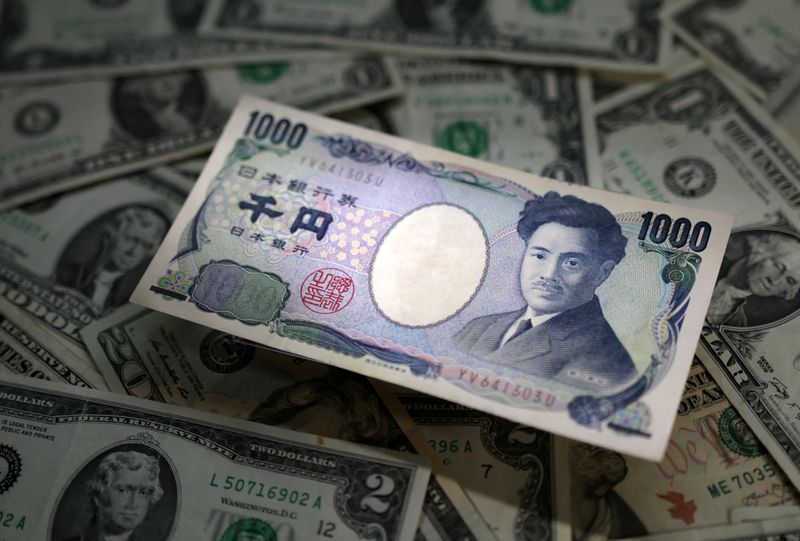Forex
Dollar slips as US job openings fall; yen lifted by safe haven bid

By Saqib Iqbal Ahmed
NEW YORK (Reuters) -The dollar eased against most major currencies after U.S. job openings data for July pointed to a softening labor market, tilting the odds further in favor of larger interest rate cuts by the U.S. Federal Reserve.
Traders on Wednesday added to bets that the Federal Reserve will deliver a half-a-percentage-point reduction at its next meeting, after data showed job openings in July fell to the lowest level in three and a half years.
Wednesday’s data release comes ahead of Friday’s U.S. payrolls report that could offer investors clues to the timing and pace of Federal Reserve interest rate cuts.
“The U.S. central bank must not keep interest rates too high much longer or it risks causing too much harm to employment, Atlanta Federal Reserve President Raphael Bostic said on Wednesday.
The Dollar Index, which measures the U.S. currency’s strength against six major peers, was down 0.3% at 101.4. Against the yen, the dollar slipped 0.9% to 144.22 yen as global financial markets traded with a broadly risk-off tone.
Investors scurried to safer assets after a sharp sell-off on Wall Street in the prior session sparked by concerns about the U.S. economy and tech sector valuations.
Soft U.S. manufacturing data released on Tuesday helped fan worries about a hard landing for the world’s biggest economy, with traders already nervous ahead of the crucial monthly payrolls numbers on Friday.
U.S. equity indexes slid on Tuesday, with AI chip giant Nvidia (NASDAQ:) tumbling nearly 10%. Wall Street’s main indexes opened lower on Wednesday.
The dollar, which tumbled more than 2% against a basket of currencies in August, has steadied since as rising volatility in global financial markets has lifted demand for safer currencies.
“Stock market instability and dropping U.S. yields have made the yen a strong performer,” said Marc Chandler, chief market strategist at Bannockburn Global Forex.
The was about 1% higher than its late August low of 100.51.
“The USD has rebounded but is afraid to rebound any further until it gets more information,” Brad Bechtel, global head of FX at Jefferies, said in a note.
“After Friday’s print we’ll either be 100 or lower or 104 or higher in DXY by my reckoning,” he said.
Economists surveyed by Reuters expect Friday’s report to show an increase of 165,000 U.S. jobs in August, up from a rise of 114,000 in July.
Ahead of that, investors will also keep a close eye on jobless claims on Thursday.
The euro was 0.3% higher at $1.1077, recovering from marginal declines earlier in the session.
Euro zone business activity received a boost from France hosting the Olympic Games last month but the malaise in the bloc is likely to return once the Paralympics wraps up as demand remains weak, a survey showed.
The Canadian dollar rose 0.2% against its U.S. counterpart on Wednesday after the Bank of Canada cut its key policy rate by 25 basis points to 4.25% as forecast but expressed concern that weaker-than-expected growth might mean inflation falls too quickly.

Sterling was 0.3% higher at $1.316, after weakening to a low of $1.31010 overnight.
With investors avoiding riskier assets, cryptocurrencies faltered on Tuesday. fell 3% to $56,400 and ether slipped about 2.5% to $2,400.

 Forex3 years ago
Forex3 years agoForex Today: the dollar is gaining strength amid gloomy sentiment at the start of the Fed’s week

 Forex3 years ago
Forex3 years agoUnbiased review of Pocket Option broker

 Forex3 years ago
Forex3 years agoDollar to pound sterling exchange rate today: Pound plummeted to its lowest since 1985

 Forex3 years ago
Forex3 years agoHow is the Australian dollar doing today?

 Cryptocurrency3 years ago
Cryptocurrency3 years agoWhat happened in the crypto market – current events today

 World3 years ago
World3 years agoWhy are modern video games an art form?

 Commodities3 years ago
Commodities3 years agoCopper continues to fall in price on expectations of lower demand in China

 Economy3 years ago
Economy3 years agoCrude oil tankers double in price due to EU anti-Russian sanctions





















